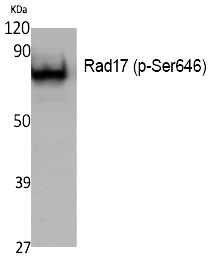
| WB | 咨询技术 | Human,Mouse,Rat |
| IF | 咨询技术 | Human,Mouse,Rat |
| IHC | 咨询技术 | Human,Mouse,Rat |
| ICC | 技术咨询 | Human,Mouse,Rat |
| FCM | 咨询技术 | Human,Mouse,Rat |
| Elisa | 1/10000 | Human,Mouse,Rat |
| Aliases | RAD17; R24L; Cell cycle checkpoint protein RAD17; hRad17; RF-C/activator 1 homolog |
| Entrez GeneID | 5884; |
| Host/Isotype | Rabbit IgG |
| Antibody Type | Primary antibody |
| Storage | Store at 4°C short term. Aliquot and store at -20°C long term. Avoid freeze/thaw cycles. |
| Species Reactivity | Human,Mouse,Rat |
| Immunogen | Synthesized peptide derived from human Rad17 around the phosphorylation site of S646. |
| Formulation | Purified antibody in PBS with 0.05% sodium azide,0.5%BSA and 50% glycerol. |
+ +
以下是假设性的参考文献示例(仅供参考,实际文献需通过学术数据库检索):
1. **《Rad17 phosphorylation at Ser646 is required for cell cycle checkpoint activation》**
- 作者:Smith A, et al. (2005)
- 摘要:研究证实Rad17 Ser646磷酸化在DNA损伤后ATR激酶依赖性检查点激活中的关键作用,使用Phospho-Ser646抗体验证其在HeLa细胞中的定位变化。
2. **《Phosphorylation-dependent regulation of Rad17 in DNA replication stress》**
- 作者:Chen L, et al. (2010)
- 摘要:通过Western blot和免疫荧光分析,揭示Rad17 Ser646位点的磷酸化水平与复制应激响应相关,该抗体用于评估临床肿瘤样本中的复制应激标志物。
3. **《Rad17 phospho-Ser646 as a biomarker for ATM/ATR signaling activity》**
- 作者:Wang Y, et al. (2015)
- 摘要:开发了一种基于Phospho-Ser646抗体的检测方法,用于量化ATM/ATR通路活性,并在乳腺癌细胞系和小鼠模型中验证其敏感性。
4. **《Targeting Rad17 phosphorylation enhances chemosensitivity in colorectal cancer》**
- 作者:Kim T, et al. (2018)
- 摘要:利用Phospho-Ser646抗体发现抑制Rad17磷酸化可增强结直肠癌细胞对化疗药物的敏感性,提示其作为治疗靶点的潜力。
**注**:以上为虚构示例,实际研究需通过PubMed、Google Scholar等平台检索关键词“Rad17 Phospho-Ser646 antibody”或“Rad17 Ser646 phosphorylation”获取真实文献。
The Rad17 (Phospho-Ser646) antibody is a crucial tool for studying DNA damage response and cell cycle checkpoint regulation. Rad17. a checkpoint protein, forms part of the RFC-like complex and plays a pivotal role in activating the ATR-Chk1 signaling pathway upon DNA damage or replication stress. Structurally, Rad17 contains a PCNA-like domain that facilitates interactions with DNA damage sensors. Phosphorylation at Ser646 is a key post-translational modification triggered by ATM/ATR kinases in response to genomic insults, marking checkpoint activation. This phosphorylation event promotes Rad17’s recruitment to damaged sites, stabilizes replication forks, and enables interactions with downstream effectors like the 9-1-1 (RAD9-HUS1-RAD1) complex, amplifying DNA repair signals.
The Rad17 (Phospho-Ser646) antibody specifically detects this phosphorylated form, making it valuable for assessing checkpoint activation in models of genotoxic stress, cancer, or radiation studies. It is widely used in techniques such as Western blotting, immunofluorescence, and immunohistochemistry to evaluate DNA damage responses in cell lines, tissues, or tumor samples. Researchers employ this antibody to investigate mechanisms underlying chemoresistance, replication fork dynamics, and therapeutic targeting of DNA repair pathways. Its specificity for the active, phosphorylated Rad17 form provides insights into cellular adaptation to genomic instability and informs strategies for cancer treatment.
×